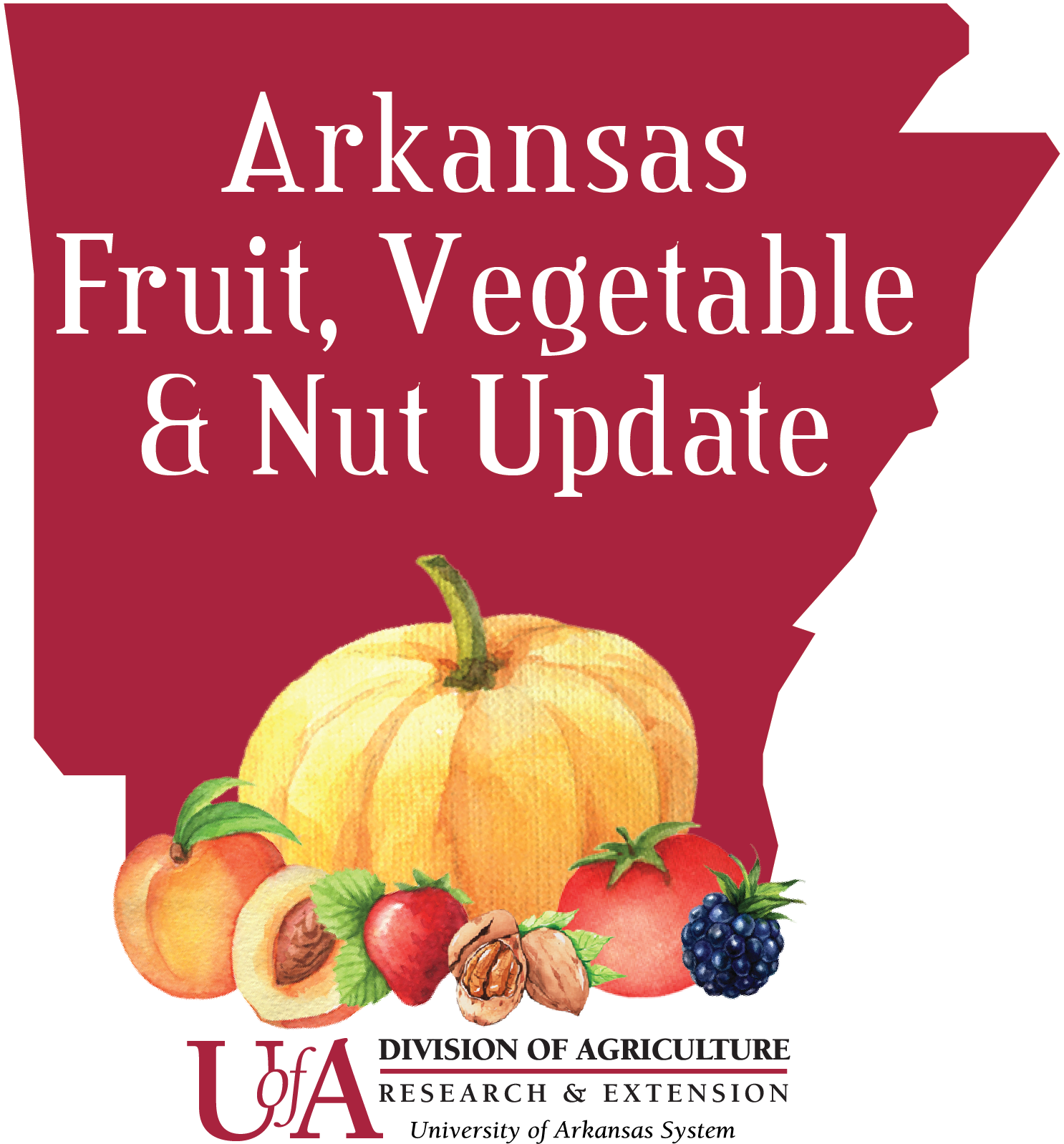
2019 Hops Production Trial
Graduate student James McClellan shares what we have learned so far from a study being conducted on the potential of growing hops in Arkansas!
During the Fall of 2018, a study was initiated at the University of Arkansas Fruit Research Station located in Clarksville, Arkansas by Drs. Renee Threllfall, Jackie Lee and Amanda McWhirt concerning the feasibility of growing Humulus lupulus, or hops, in Arkansas’ climate. The team is also working with two established on-farm sites (Booneville and West Fork, Arkansas). This project is supported by a grant from the Arkansas Department of Agriculture’s Specialty Crop Block Grant Program.
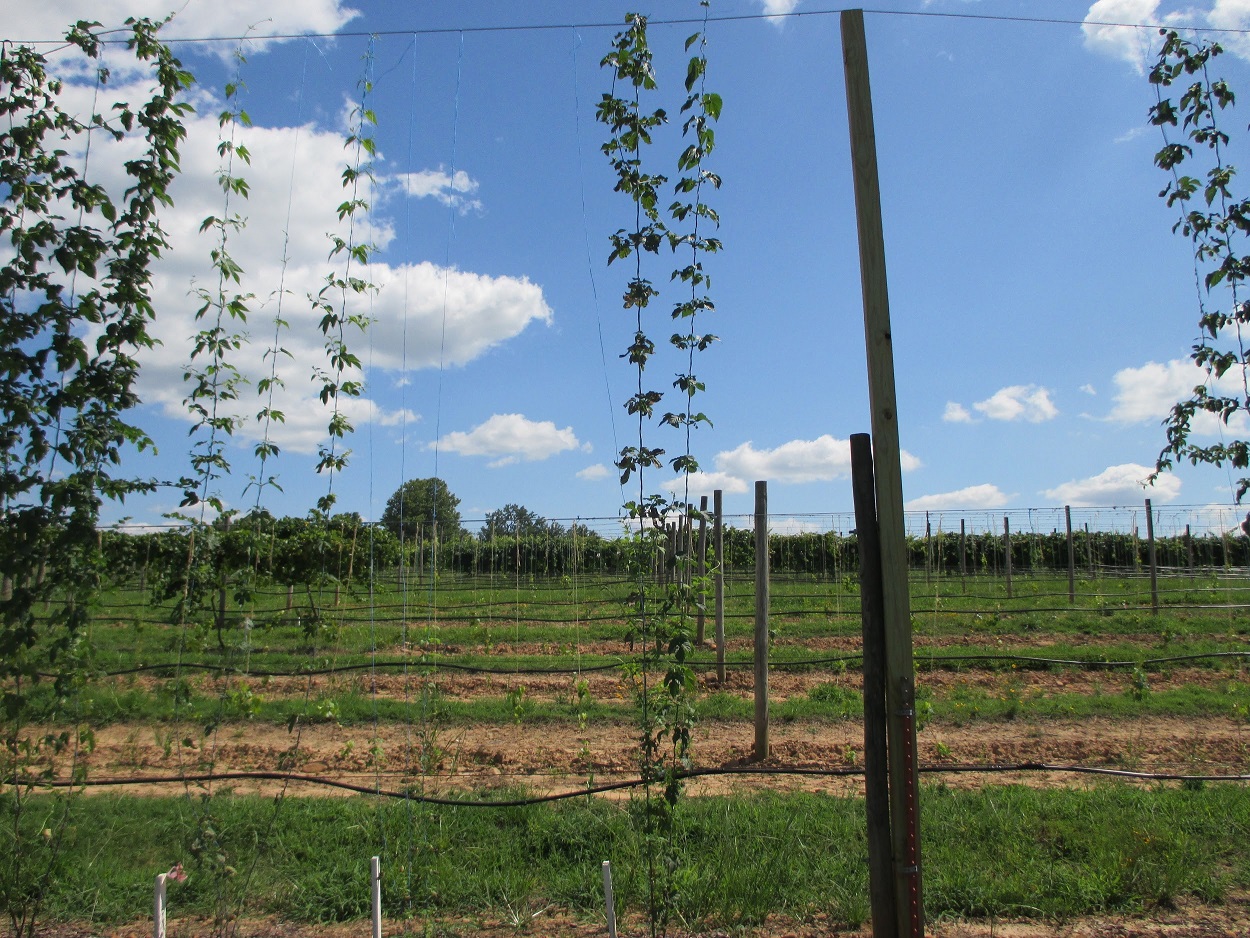 Picture 1: Hop bines growing along training wire.
Picture 1: Hop bines growing along training wire.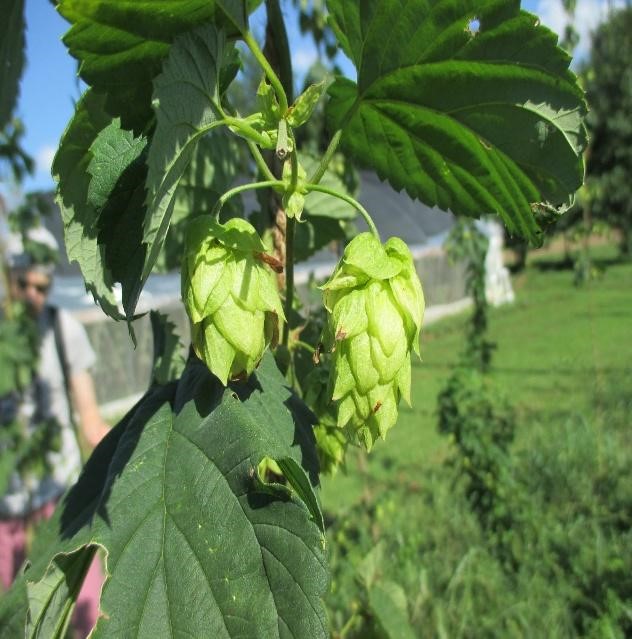
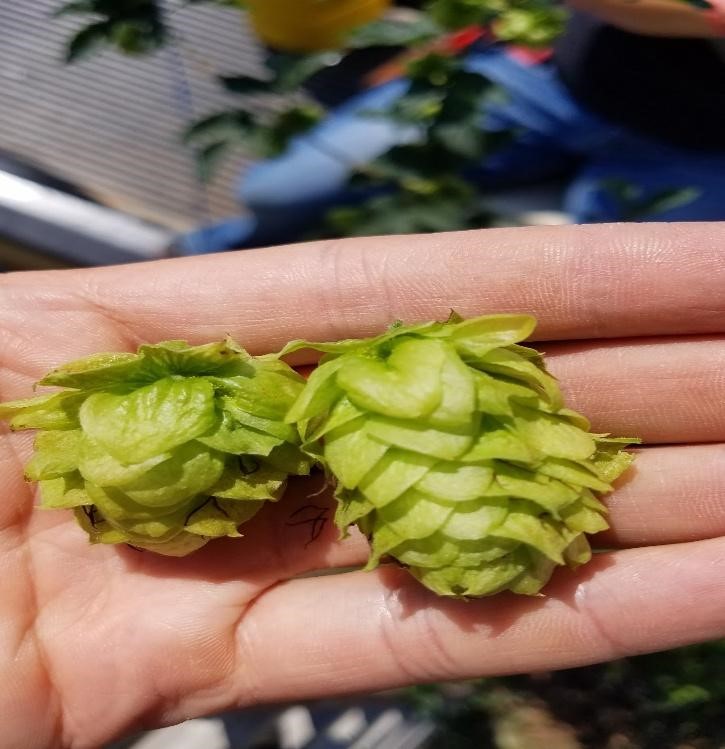 Picture 3: Two hop cones after harvest.
Picture 3: Two hop cones after harvest.
Although hops are primarily grown in the Pacific Northwest, the state’s burgeoning microbrewery industry along with a general trend toward enjoying the unique aroma and flavor profiles that hops impart on craft beer has piqued the interests of Arkansas researchers, home growers, and microbrewers alike regarding the possibility of growing hops in our region. Possible limitations to growing hops in Arkansas are the state’s warmer, more humid summer days and fewer daylight hours which may limit optimal hop cone development. Therefore, one of the major goals of this research trial is to evaluate the potential for hops production in the state by assessing the rate of growth and morphological characteristics of cultivars during their first year, including canopy and lateral shoot formation, the impact of pruning at different times, node number and location along bines, overall yield, and the susceptibility of the cultivars to pests and diseases.
The trial at the UA Fruit Research Station is composed of nine 18’ plots, each planted with six common hops cultivars (Cascade, Nugget, Zeus (CTZ), Cashmere, Centennial, and Crystal). The cultivars are randomized within each plot and evenly spaced 2.5’ apart. An additional 22.5’ plot of nine hops (Cascade variety) is being used to assess the effects of shoot pruning at three different dates. Each plot is separated every twenty-four feet by a 15’ tall wooden post that supports a metal trellising wire. Each plant has three training lines going to the trellising wire to support three bines per plant. Prowl pre-emergent herbicide was used in September 2018 prior to planting, and in late October of 2018 each hop was planted using a hand trowel and immediately watered. Planting hops later in the Fall, while acceptable, is not the only time that they can be planted. In fact, planting early in the Spring may be ideal due to the longer growing season each hop plant will have before going dormant the following winter. A small amount of compost was placed around each plant to conserve soil moisture. The hops then entered a dormant state during the winter and all above ground growth died back to the ground.
Plant Survival Estimates During Winter of 2018-2019 of 6 Hops Varieties
New growth shoots began emerging in late March of 2019, and assessments of plant survival were taken on March 25. It was evident that several of the varieties struggled to survive through the winter, especially the Nugget and Cashmere cultivars. Plants were sourced from two locations in the fall of 2018 and differences in transplant size at planting in October may have contributed in part to this observation.
Pruning Date Trial
There were 3 pruning dates: Early (April 15th), Mid (April 30th) and Late (May 15th). Pruning involves cutting all newly emerged shoots to ground level in order to encourage the emergence and rapid development of later bines that will be trained (Pictures 4 & 5). This trial was only conducted on a block of Cascade plants separate from the variety trial. All variety trial plants were pruned on April 30th.
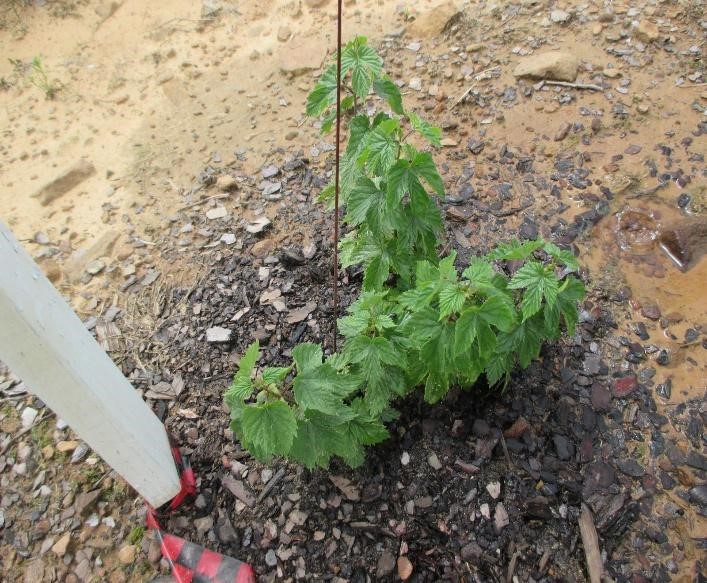 Picture 4: Zeus prior to pruning
Picture 4: Zeus prior to pruning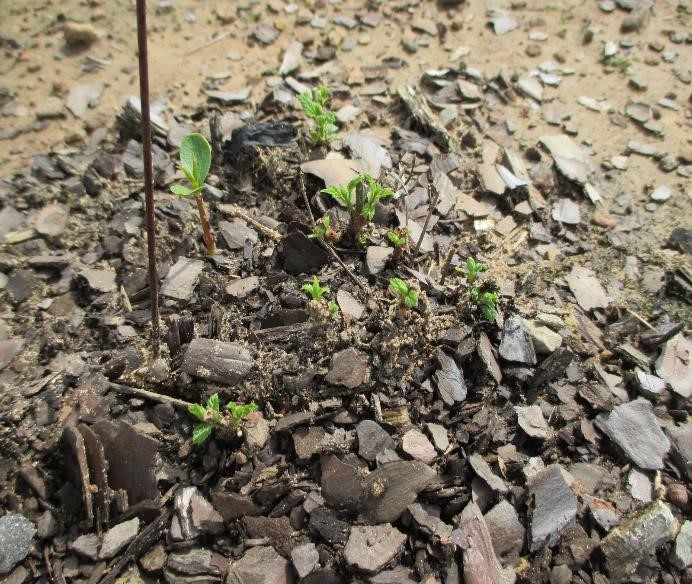 Picture 5: Zeus one week after pruning
Picture 5: Zeus one week after pruning
Fertilizer
On April 30th, 2019 the first application of fertilizer (approximately 48.68g of 13-13-13 per plot or 8.11 g per plant) was scattered by hand. On May 15th, the second round of fertilizer at the same rate was applied, Prowl pre-emergent herbicide (2qts/ac) and a fungicide (Pristine - 28oz/ac) was also used.
Plant Vigor Assessments
On May 17th, 2019 most of the missing Cashmere hops plants were replanted and immediately watered, and all remaining plants were assessed for regrowth. All cultivars, except Zeus, experienced slow shoot reemergence. The missing Nugget variety plants were left unplanted at this time due to a shortage of available transplants.
Training and Trellising
On May 31st, a hand-crank system was installed to the first wooden post which fed a metal wire across the top of each 15’ beam in order to bolster and eventually lower the bines to facilitate the harvesting process. Also, the third application of granular fertilizer (97.36g of 13-13-13 per plot or 16.23g per plant) was spread by hand, and multiple two-prong landscape fabric staples each with three 15’ pieces of bailing twine attached were implanted at the base of all remaining hops and tied to the top of the trellis wire. During the following week (started June 11th), the three most promising, newly-emerged shoots from each plant were trained clockwise on the twine (Picture 6) while any additional shoots throughout the remainder of the summer season were cut back to the ground.
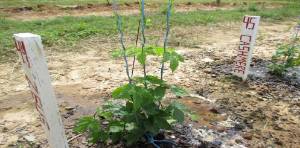
Picture 6: Zeus shoots (3) trained along twine - taken June 12th
Pest Management
Shortly after training, several tell-tale signs of insects (specifically army worms and spider mites) and fungal disease (thought to be downy mildew) developed on the foliage (Pictures 7-8). A weekly scouting regimen began on June 12th in Clarksville, and biweekly at other sites. Pest scouting entailed randomly sampling 5 leaves from each plant and, often using a watch repair eyeglass kit with a 10x magnification lens. Both sides of the foliage were examined and any pests or diseases found were recorded and overall plant health was rated according to the percent of foliage affected.
An initial fungicide spray application of 2.5lbs/ac of Aliette was applied on June 12th. An insecticide spray application (4oz/ac using Mustang Maxx) was sprayed June 19th. Biweekly, spray applications of both fungicide and insecticide (alternating Aliette or Pristine with Mustang Maxx) commenced to control for pests and fungal growth. The previously established, observational grow sites in West Fork and Booneville also experienced infestations of army worms and downy mildew, so a backpack spray application of Dipel (2tsp/g) in West Fork and a combination of copper and B.T. (Bacillus thuringiensis) in Booneville were spread on the 14th and 16th of June, respectively.
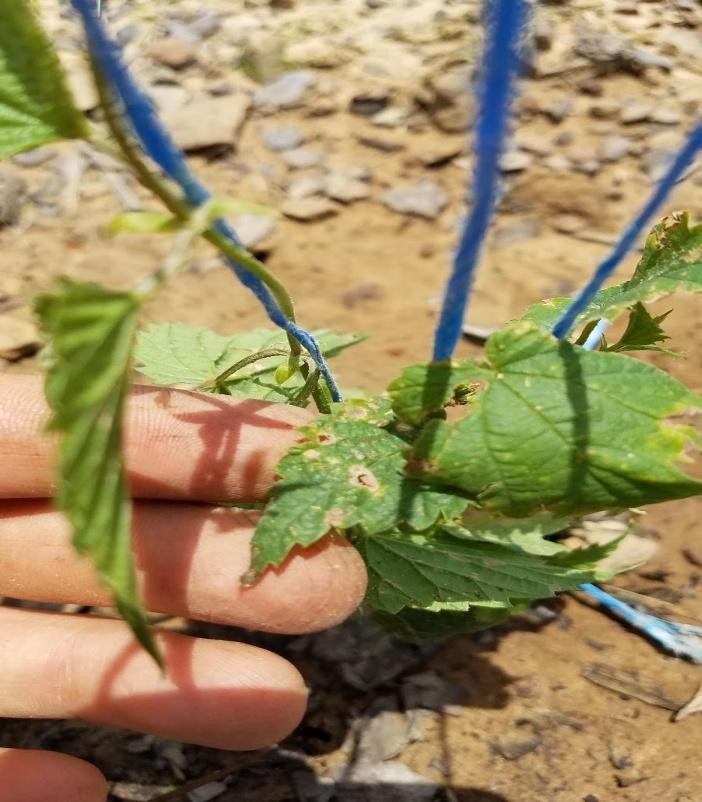 Picture 7: Potential army worm/mite damage
Picture 7: Potential army worm/mite damage 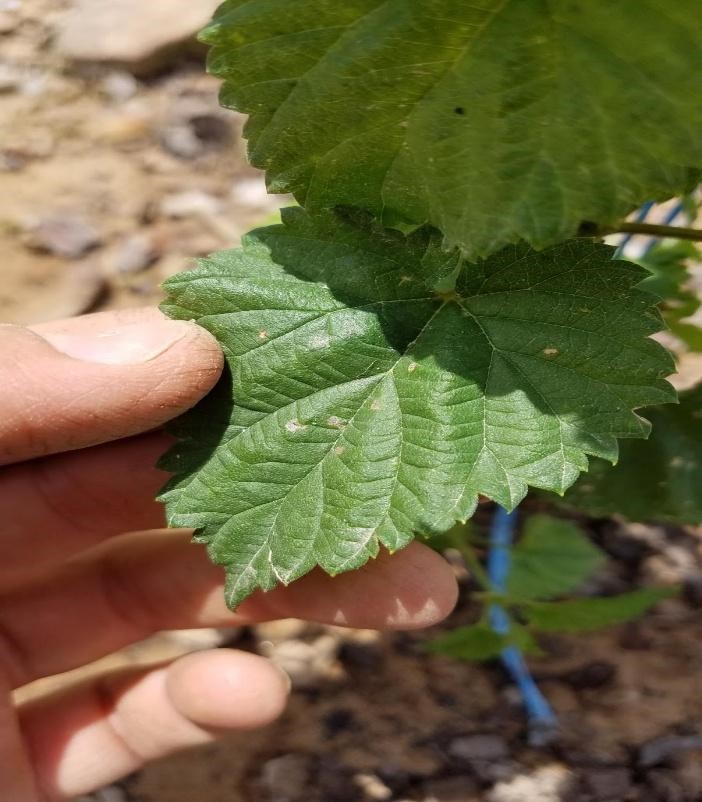 Picture 8: Potential fungal disease
Picture 8: Potential fungal disease
Once trained, each of the three shoots from all remaining plants continued growing upward along the twine and each bine was checked biweekly for relative height to the trellis wire, overall plant vigor (rated as poor, good, or excellent), presence of flowers, and the formation of laterals to assess the progression of growth. Additionally, one plant from each cultivar was flagged and photographed on a weekly basis for visual documentation. Lateral shoots or side stems typically form at each node along the entire length of the main bines (one or two laterals per node may form, 2 is most common). Lateral shoots are usually where the plant produces flowers and eventually the cones are formed (Picture 9) . For this reason lateral shoot production may be a key indicator of potential yield.
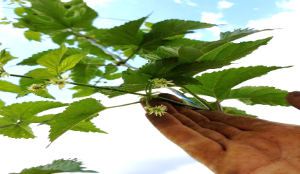
Picture 9: Female flowers emerging from the lateral of a ‘Zeus’ bine in late June
Data Collection of Physical Characteristics
The first data collection and observations on plant characteristics took place at the UA Fruit Research Station on June 23rd and it was evident that the bines of the Zeus and Cascade cultivars (variety trial and pruning study) exhibited the greatest lateral shoot production, grew to the top of the trellis wire more quickly (Pictures 10-13), and had the greater plant vigor compared to the other four varieties within the trial. Each bine was measured for overall height, the number of nodes were counted, and it was noted whether each node emitted one or two laterals.
The other varieties, with the exception of Nugget which had one surviving hop plant by the end of the summer, also grew and formed laterals over the course of June and July, but not to the extent that Cascade and Zeus did. These three varieties also showed flower emergence and cone set several weeks after Zeus and Cascade. During the first week of July, nearly all Zeus and Cascade hops exhibited cone formation along 2’-3’laterals while several of the Crystal and Cashmere cultivars produced flowers. The remaining Nugget variety and all Centennial hops did not flower until the fourth week of July.
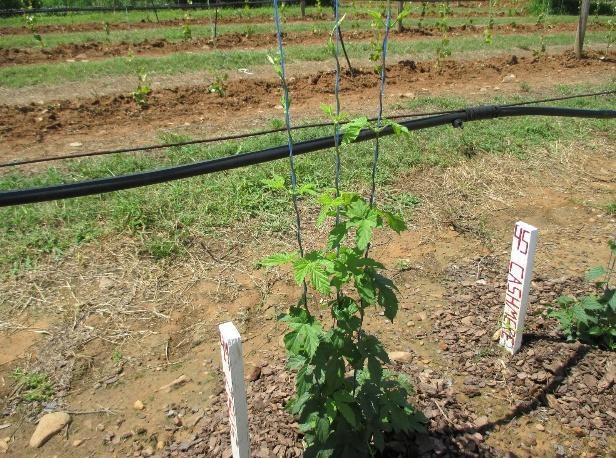 Picture 10: Zeus plant 6/19/19
Picture 10: Zeus plant 6/19/19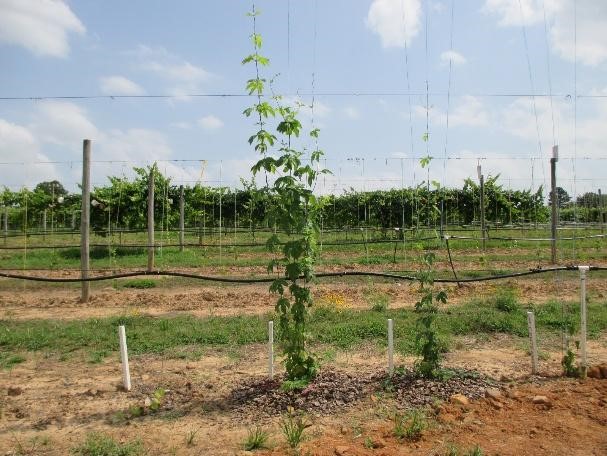 Picture 11: Zeus plant 7/5/19
Picture 11: Zeus plant 7/5/19
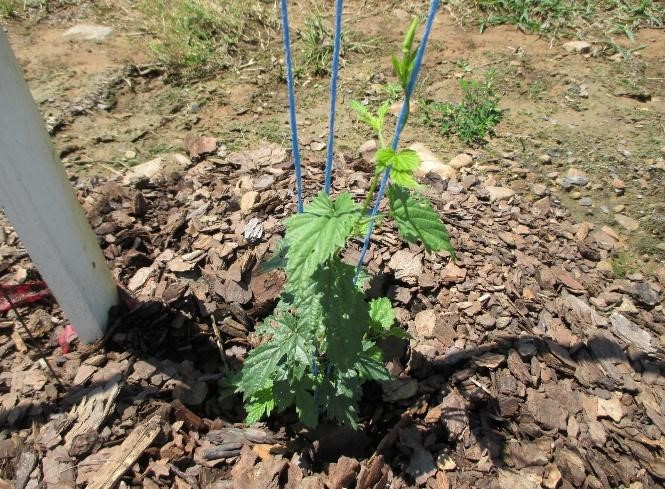 Picture 12: Cascade plant 6/19/19
Picture 12: Cascade plant 6/19/19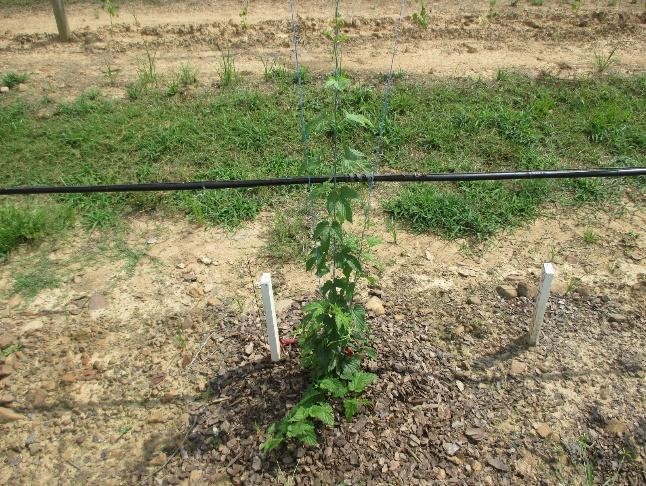 Picture 13: Cascade plant 7/5/19
Picture 13: Cascade plant 7/5/19
Pruning Study
No major visual differences in hop plant vigor were noticed between the different pruning dates on Cascade. However in late June the “early” pruning date had a taller plants, more nodes per bine and more nodes with 2 laterals. Later in July these differences were not as evident and all of the pruning dates has similar measures of node number and lateral number and all bines had set cones.
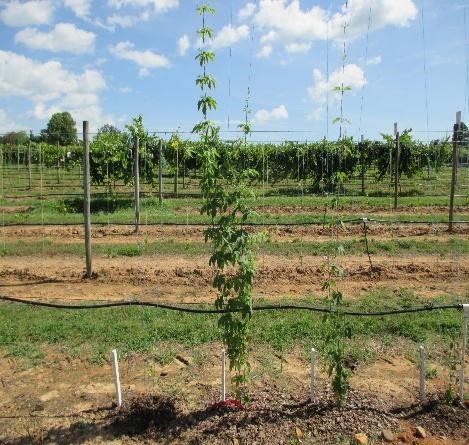
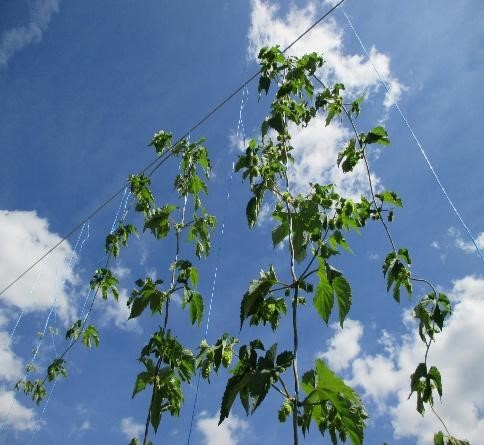
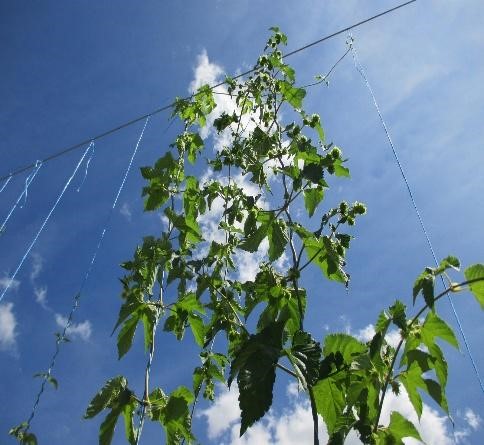
Pictures 14-16: Zeus bines reaching top of the 15’ trellis wire and beyond with cones emerging from all upper laterals (July 11)
Harvesting Hops
After the third date of data collection on plant characteristics, it was evident that practically all of the Zeus and Cascade cultivars were ready to harvest based on several factors: overall shape, texture, size of the cones, development of lupulin glands within the hops cones, and the comparison to harvested hops at the observational grow sites. During development, the hops cones feel compressed and moist to the touch, and as they age the hops develop a distinct paper-like, crisp consistency and they exude an aroma that is often compared to freshly cut grass or green onions when crushed. Another sign that the cones were ready to harvest was the development of bright yellow lupulin inside of the thin folds called bracteoles; these sticky compounds contain the acids, aromatic oils, and resins that give the hops their distinct smell and taste once dried and incorporated into tea or beer.
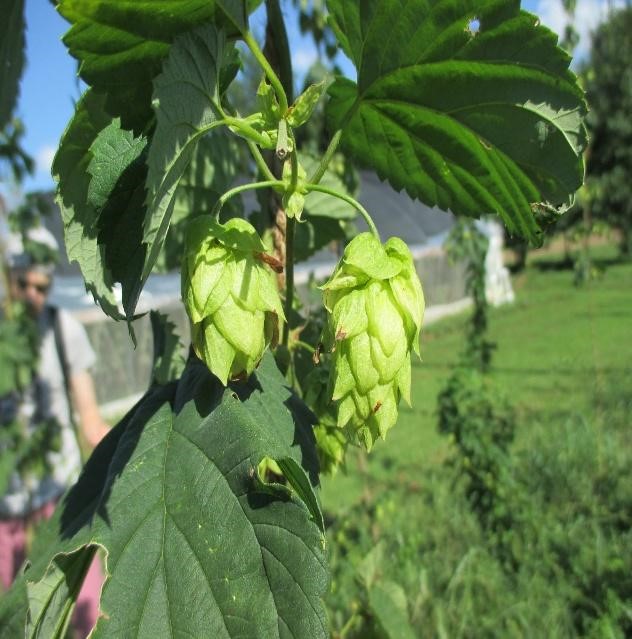 Picture 17: Chinook hops before harvest - West Fork, AR site
Picture 17: Chinook hops before harvest - West Fork, AR site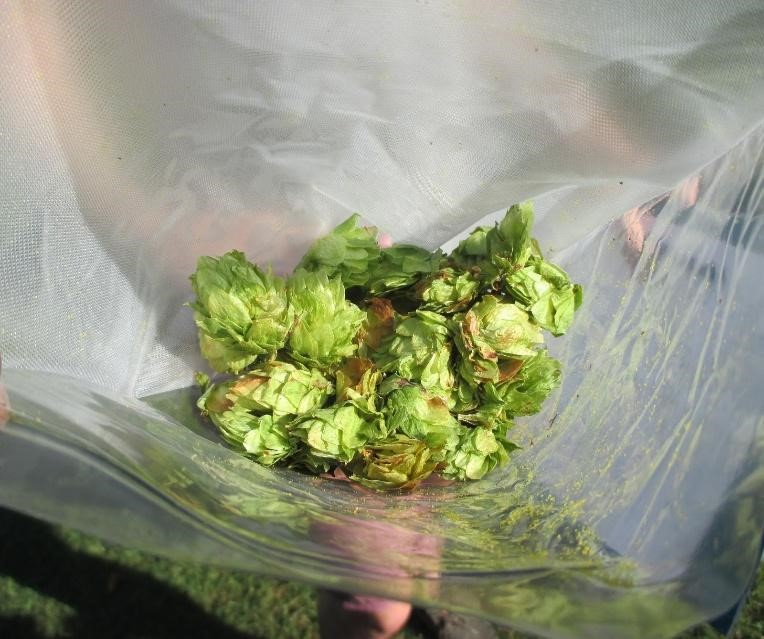 Picture 18: Cascade hops after harvest - West Fork, AR
Picture 18: Cascade hops after harvest - West Fork, AR
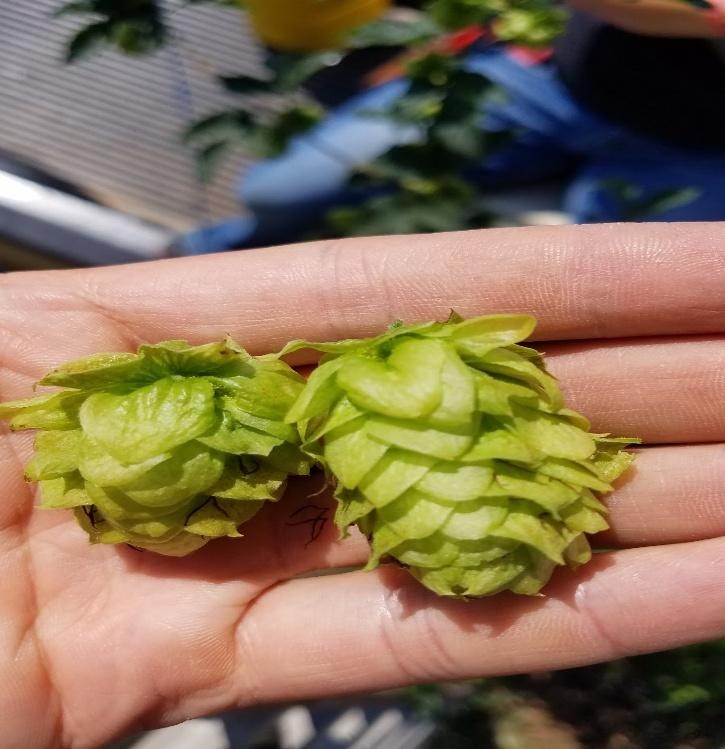 Picture 19: Zeus cones prior to drying
Picture 19: Zeus cones prior to drying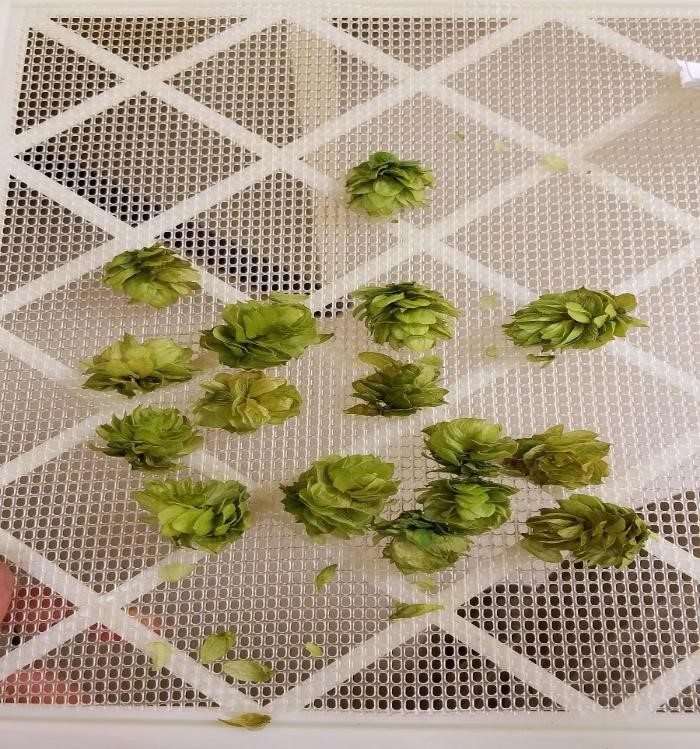 Picture 20: Zeus cones immediately after drying for 4 hours
Picture 20: Zeus cones immediately after drying for 4 hours
The hops are still being collected and analyzed at the Fruit Research Station and at the University’s Food Science Department, and by comparing the latest data regarding the physical characteristics of the cultivars alongside the harvest information, several key takeaways are evident. Both Zeus and Cascade exhibited the most promising lateral growth and cone development, and they resisted disease pressure to a greater extent throughout the growing period. The Cascade cultivar produced slightly more double laterals on average (standard and pruning study) while the Zeus variety displayed the most rapid growth to the top of the trellis along with an earlier flowering time, slightly longer lateral length, greater overall cone size and relative height to the trellis. Within the Cascade shoot pruning trial, the data also indicates that the bines cut down at the early or late times (April 15th and May 15th) have slightly smaller average cone weight than the May 1st date. This is despite that the May 1st planting data had slightly shorter bines and similar node and lateral counts. These comments are only based off of preliminary observations and comparisons of numerical not statistical differences. Further analysis will be required to determine if these pruning dates impacts Arkansas hop yields.
The remainder of the hops from these two varieties along with the Centennial, Cashmere, Crystal, and Nugget cultivars are expected to be harvested on a weekly schedule over the course of several dates in August. This information will add to the ongoing study at the Fruit Research Station and allow the team of homegrowers and researchers to assess the feasibility of hops production in the region.
Stay tuned as we will continue to keep you updated on this study!